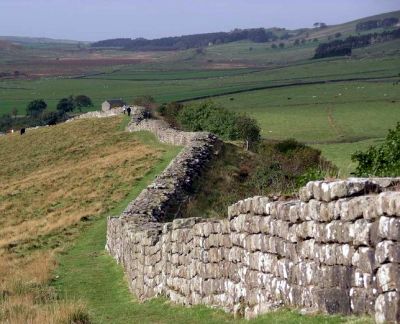The mythology surrounding James Hutton and Hadrian’s Wall

There is a certain mythology that has grown up in geological circles around James Hutton (1726–1797), the Scottish physician widely regarded as the father of modern geology. The legend that passes along the corridors of academia makes a good story for geology students looking for a hero. You can find versions of the legend on the web by Googling “James Hutton Hadrian’s Wall”.
According to the story, James Hutton, using his keen observation skills, discovered that the earth was unimaginably old—much older than the 5,800 years he learned during his early Presbyterian upbringing.
His seminal moment came, so the story goes, after returning from Hadrian’s Wall, which was built in Britain by the Romans in AD 122. Hutton observed that, in more than 1500 years, the wall was hardly touched by erosion. Yet the volcanos in the area had been much eroded. And when he visited Siccar Point on the coast east of Edinburgh, he found evidence of ‘former continents’ that had been entirely worn away. Thus, by his careful observation and by logical deduction he discovered geological time.
But the reality is quite different.
First, James Hutton’s logic was flawed. He ignored the history of this planet as recorded in the Bible and did not consider the geological effects of Noah’s Flood. If he had, he would have found that the biblical age of the earth is consistent with biblical history. The catastrophic movement of water during the Flood explains how the erosion that Hutton observed at Siccar Point actually occurred in a short time. Hutton should have realized that Hadrian’s Wall was built after Noah’s Flood. When he compared the erosion on Hadrian’s Wall with the erosion on volcanos in the area, and with the erosion at Siccar Point, it was an invalid comparison. He was comparing things that are not comparable.
Second, he allowed his preconceived ideas to affect his observations. Because he imagined slow-and-gradual geological processes in the past he missed the obvious evidence for geological catastrophe at Siccar Point. To be fair, he was not aware of turbidites, catastrophic sedimentary processes only discovered following the Grand Banks earthquake off the coast of Newfoundland in 1929.
It’s a nice story but it’s not accurate. Visit Siccar Point today and you can see for yourself the abundant evidence for catastrophe, consistent with the biblical Flood. For details of this evidence see Unmasking a long-age icon.

Readers’ comments
Comments are automatically closed 14 days after publication.